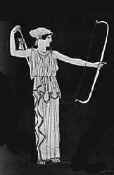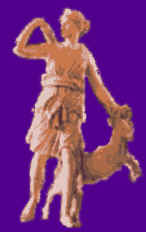 |
Ares |
The Amazons main pantheon of deities were, Artemis, Ares, and Cybele. These three deities however are not exclusive to the Amazons. Namely, alternative theories state that the Amazons worshipped Artemis (in all of her aspects), Ares, Cybele, Astraea (daughter of Themis), Hecate, and Athena, as well as other deities (some sources have gone so far as to state the Amazons worshipped Indian, or non-native gods from the Aegean). The Amazon deities represent several archetypes which related to the Amazon way of life.
 |
Ares |
The worship of Ares in the Amazon pantheon is obvious in relation to the way of life of the Amazons. Ares, the Greek god of war, held domain over battles, warriors, soldiers, but also to the rage of war (hence he's been given the attribute of a berserker).
 |
Artemis |
The worship of Cybele and Artemis are also in direct relation to the Amazons way of life. Both Cybele and Artemis are both Goddesses representative of the moon. The moon through out history has been seen as a symbol of the feminine; and it's regular cycles correspond to the lifecycles of women: maiden, mother, and crone. Both Cybele and Artemis were connected to the moon with many different aspects, not entirely corresponding to the triad of maiden, mother and crone. For example, the Goddess Artemis, was celebrated with many differing aspects among them, she was known and celebrated as Artemis Brauron, and in her most violent aspect the tauropolos. Artemis's main domain was over childbirth, hunting, the protection of small children, the healing of small children, the protection of girls, etc. She also held special significance as the goddess over adolescence, and childhood. The goddess Cybele (also known as the Titan Rhea), held significance as a goddess of the moon and of fertility, but who was also worshipped in her earthly aspects, as a fertility deity. Both Cybele and Artemis are largely a contrast to one another. Artemis who represented a wild sense of feminity in one instance, and in another aspect represented a nurturing aspect, in quite another was the sublime virgin goddess. This virginity was held in such high regard within the myths of Artemis, that in one, when Actaeon sees the goddess bathing, he is turned into a stag by Artemis and his hunting dogs tear him apart. Rarely if at all is Artemis ever seen as a goddess with domain over motherhood (the closest she comes is holding domain over childbirth, owing to her painless birth by Leto). Cybele alternately, (also known as Rhea) was the Titan mother of the Olympian gods, who held domain over fertility, the earth, etc. Though it was through the union of the Titans Rhea and Cronos that Zues was born , and later form Zues and Leto (who was also born from the Titans Phoebe and Coeus), that Artemis was born, there is little to support that Cybele was an incorportated aspect of Artemis, though Cybele was probably worshipped by the Amazons. Taken together the worship of both goddesses do not suggest that Amazon worship was a compilation of maiden, mother, and crone aspects, rather than each goddess had their own aspects as were thought of as separate deities.

Worship of the Goddess Artemis took place through out the Ancient Greek world. In Athens, the festival of Artemis Brauron was celebrated to comemorate the myth of Callisto. Within the myth, Artemis turns Callisto (one of her nymphs) into a she bear after finding out that she had became pregnant by Zues. Artemis required of her nymphs (and followers for that matter), to uphold the same chaste existence that she did. In the festival of Brauron, several Athenian girls were chosen to serve as she bears in the temple of Artemis. These girls ranging from the age of 5 to 10 would act as she bears, performing service to the community in comemoration of the myth. Little is known about what actually happened during the festival of Brauron in the ritualistic sense, however as a rite of passage for a few girls, the festival itself was part of a chain of other festivals to make a young girls transition from one position or aspect of life to another. In particular before the marriage of an Athenian girl, she was expected to give up all of her childhood toys and to bring them to the temple of Artemis, in effect this event exemplifies the transition from the life of a wild youth, to that of a "civilized" or married woman.
The symbollism of the festival of Brauron and the worship of Artemis, takes place on several levels. The Festival of Brauron marks a time when two girls symbollically serve the community and act as she bears. Such a myth delves into the Athenian (and possibly further the general Greek), view of women and their transition from one phase of life to another. A girl in ancient Greece was expected to marry, and thus have children. Thus, in committing to marriage they were no longer virgins, and the festival of Brauron possibly served the purpose of attoning for the eventual loss of a girls virginity (or even the entire communities). Similarly, the goddess Artemis held domain over the country dwelling women, over childbirth and childhood, nature, etc. all aspects which take and place a young woman or girl outside of the city (or polis), into the realm of natural, unbridaled, and wild. When a girl in Athens married they gave up their toys to Artemis, in effect making their transition from the wild days of their girlhood, to their eventual womanhood.
Geneaology and Traits of Artemis and Apollo |
|||
| Cronos - Ruler of the Universe (Prior to the Olympian take over) | Rhea - Ruler over the Earth | Phoebe - Titan of the Moon | Coeus - Titan of Intelligence |
Zues |
Leto |
||
Artemis Domain - Eternal Virgin. Goddess of the Hunt. Held rule in Athens (and other parts) over Childbirth (because of Leto's painless birth), childhood (childhood diseases), Adolescence. Had many differing aspects or archetypes the most violent was the tauropolos).
Birth - Born on Ortyegia or Delos (either is disputable). Born before Apollo, a painless birth. Because of the painless birth she was given domain over childbirth. Relationship to Women - Artemis was one of the Amazons prime deities worshipped. Her violent and non-violent aspects were emphasized. Artemis of Brauron - Callisto was seduced by Zues, and Artemis noticed she was with child. At this she turned her into a bear. Zues saved Callisto at the last minute, and thus she held domain in the sky over the star Spica. Hence the festival of Brauron, is a rememberance of that. . . . The festival of Brauron involved girls acting and dressing up like bears. Within the festival of Brauron, the girls spent a certain amount of time in the temple, acting like she-bears, and doing work for the community, symbols of atonement for Callisto's act. (was done yearly and only with a few girls involved.
|
Apollo Domain - Healing, Music, Intellect, Seer, Archer, Patron of the Arts,
Slayer of the Serprent which went after Leto (Serpent was originally sent by Hera who
didn't like Zues' consorting, etc). Birth - Born on mount Cynthas near Delos -
Right after Artemis. Was fed with nectar/ambrosia, etc. by Themis. Relationship with Hyacinthus - Flying
discus possibly diverted by the western wind (Zephyrus) Zephyrus was jealous of
Hyacinthus' relationship with Apollo, and sent it askew. (Takes on Intellect of Coeus) |
||
In the case of the Amazons, who worshipped Artemis, and who were seen by the Greeks as wild women, the Amazons worship of Artemis takes on a dual meaning. While Artemis represented a goddess of nature, the hunt, childbirth, and other aspects feminine, she also had her darker aspects. Namely, wild women in Greece, especially those such as the Amazons were seen as unnatural. Either the Amazons were seen as man hating killers, or as wild women, in either case they were outside of the social norms of classical Greek societies such as Athens. Thus, it is not beyond theory to assume that the Amazons stood outside of normal Greek civilization, in the realm of wild and unbridaled nature, and in the completely mythological sense, they served as examples of the fierceness of an untamed, unmarried, or uncivilized woman or girl.
A mythological analysis of Artemis and her twin brother Apollo illustrate the view that Amazon women stood out from the rest of Greek civilization. The table at left shows the geneaology of the Gods, Artemis and Apollo. Artemis and Apollo were twins. Their parents were Zues and Leto. Leto's parents were Phoebe, -Titan of the Moon, and Coes the Titan of intelligence. Zues's parents were Cronos, Titan over all the universe (until the Olympian gods took over), and the Titan Rhea, who held domain over all the earth.
The attributes of Artemis and Apollo are not in direct dichotomy to one another, though they are different. Artemis was born on the island of Ortyegia before her brother Apollo. Apollo was born on the island of Cynthas, near Delos. The attributes of Artemis follow she held domain over childbirth, women of the countryside, the protection of animals, hunting, etc. Her brother Apollo held domain over healing, prophecy (he held domain over the oracle of Delphi), music, poetry, philosophy, astronomy, mathematics, medicine, science, and archery. Both deities occupy two differing positions in Greek society. Namely, as Apollo is male, his main domain lay within the arts that would be practiced by usual Athenian or Greek citizen men within the city, the "civilized" arts included: music, philosophy, astronomy etc. All aspects which were to the exclusion of women in classical Greece. Similarly in the myth of Hyacinth where, in the midst of a game of quoites (discus), Apollo throws the discus and accidently hits and kills Hyacinthus a close male friend of his. Apollo is saddened so much that he creates the Hyacinth flower, which has the initials of H, and A on the petals. It is not beyond speculation that the relationship between Apollo and Hyacinthus had possible homosexual overtones, which would not be unusual for the typical male of classical Greek society. In addition, Apollo was fed by the goddess Themis, sweet nectar and ambrosia. Themis is the goddess of right order, laws, mother of the fates, and hours (seasons). The appearance of this note in the Greek myth suggests that Apollo was born (as a representative of the traditional Greek male), into the concept of a natural order, or the natural way things should be in Greek civilization. Hence, Apollo symbolizes the typical Greek male, and does so as it is a part of the natural order. The domain of Artemis in contrast represents the traditional view and standing of women in ancient Greece. This contrast illustrates the difference between men and women in mythological thought, that women were closer to nature, were mysterious, had the power of life and death, and that they held domain over women's work in life. The emphasis on virginity when a girl married also fits into the domain of Artemis, in that in Athenian society, it was written by Vernant, that "Girls were meant to be kept, while boys were mean to be taught (cultured, etc.)."